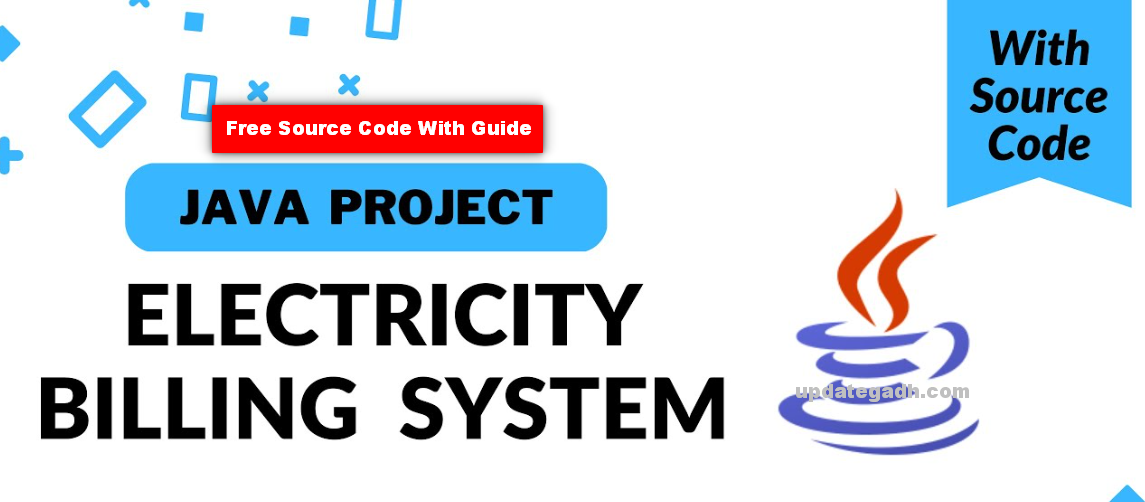Electricity Billing System in Java and MySQL
Introduction
In today’s digital era, where efficiency and accuracy are paramount, the need for streamlined processes in essential services like electricity billing is undeniable. Developing an Electricity Billing System using Java and MySQL presents a practical solution to enhance the management of billing operations. This blog post will guide you through the intricate steps of creating such a system, focusing on essential features, required tools, and the seamless execution of the project.

Table of Contents
Step 1: Making the Project
Begin by establishing a structured project layout in Java. Leveraging frameworks like Spring Boot or JavaFX can expedite development and ensure scalability. Define robust classes for entities such as customers, meters, and bills, and implement essential functionalities such as CRUD operations (Create, Read, Update, Delete).
Check 100+ JAVA Spring Boot Projects with Source Code
Step 2: Essential Features
- Customer Management: Develop modules for adding, updating, and deleting customer details. Ensure seamless retrieval of customer information for billing purposes.
- Meter Management: Implement functionalities to manage meter details and establish associations with respective customers. Facilitate easy tracking and maintenance of meter readings.
- Billing Calculation: Integrate algorithms to accurately calculate electricity consumption based on meter readings and tariff rates. Generate detailed bills showcasing usage information and applicable charges.
- Payment Processing: Develop a robust system to record and track payments made by customers. Ensure secure transaction handling and timely updating of payment statuses.
- Reporting: Implement reporting functionalities to generate comprehensive reports on usage trends, billing history, outstanding payments, and revenue analysis. Enable stakeholders to make informed decisions based on insightful data.

Step 3: Required Software and Tools
To effectively develop and run the Electricity Billing System, ensure the following tools are installed and configured:
- Java Development Kit (JDK): Essential for Java development, providing the necessary tools and libraries.
- Integrated Development Environment (IDE): Utilize popular IDEs such as IntelliJ IDEA or Eclipse for streamlined coding, debugging, and project management.
- MySQL Database: Set up and configure a MySQL database to store customer, meter, and billing information securely.
- JDBC Driver: Install JDBC driver to facilitate seamless communication between the Java application and MySQL database, ensuring efficient data retrieval and manipulation
- Java Development Kit (JDK): Install JDK to write, compile, and run Java code.
- Eclipse IDE: Use Eclipse IDE for Java development, providing features like code suggestion, debugging, and code refactoring.
- MySQL Server: Set up a MySQL server to create and manage the database for the banking system.
- MySQL Workbench: Use MySQL Workbench as a graphical user interface for interacting with the MySQL database.
- JDBC Driver: Download and configure the JDBC driver for MySQL to establish a connection between Java and MySQL.
- Swing or JavaFX Libraries: Choose either Swing or JavaFX libraries to create a user-friendly graphical interface.
Step 4: Running Project
After configuring the project and establishing database connections, execute the application from the IDE. Thoroughly test functionalities such as customer and meter management, billing calculation, payment processing, and reporting to ensure seamless operation.
How To Run The Project?
Open Eclipse Enterprise Edition. [Install if not available]
Step 1: Click On File > Import “Project Zip”
Step 2. Right Click On Project > Run As > Run On Server > Select Tomcat > Next > Finish
Step 3: In The Server Tab > Double Click On Tomcat Server > Ports
Step 4: Check Running The Site At http://localhost:8083
Step 5: Done Your Project is ready to use .

Step 5: Project Screenshots
Enhance understanding and visual appeal by including screenshots depicting various aspects of the application. Showcase the user interface, customer and meter management screens, bill generation process, payment processing interface, and sample reports.

Step 6: Download Project
Provide a convenient link to download the project source code. Encourage interested individuals to explore the codebase, contribute enhancements, or utilize it as a reference for their projects.
Virus note: All files are scanned once-a-day by updategadh.com for viruses, but new viruses come out every day, so no prevention program can catch 100% of them
FOR YOUR OWN SAFETY, PLEASE:
1. Re-scan downloaded files using your personal virus checker before using it.
2. NEVER, EVER run compiled files (.exe’s, .ocx’s, .dll’s etc.)–only run source code.
Note: Only for Educational Purpose
Download Electricity Billing System in Java and MySQL Click here

How to setup this Project Complete video – Click here
Check more Projects :- https://www.youtube.com/@Decodeit2/playlists
Step 7: Conclusion
In conclusion, the development of an Electricity Billing System using Java and MySQL presents a transformative solution to streamline billing operations. By incorporating essential features and leveraging the robustness of Java and MySQL, this system ensures efficiency, accuracy, and reliability throughout the billing process, benefiting both service providers and customers alike.
Time Required for Development
The time required to develop a library management system project can vary depending on multiple factors, such as the complexity of the requirements, the size of the library, and the availability of resources. Generally, the development process can take several months to a year, considering the various stages involved. Here is a rough breakdown of the time required for each stage:
- Project Planning: 1-2 weeks
- Requirements Gathering: 2-4 weeks
- System Design: 2-4 weeks
- Database Design: 1-2 weeks
- Development: 3-6 months
- Testing: 2-4 weeks
- Deployment: 1-2 weeks
- Training and User Support: Ongoing
Keep in mind that these timeframes are approximate and can vary depending on the specific circumstances of each library management system project.
Tags and SEO
Electricity Billing System, Java, MySQL, Billing Operations, Software Development, Project Management, JavaFX, Database Management, Reporting.
| electricity billing system project report |
| prepaid electricity billing system with recharge facility |
| class diagram for electricity billing system |
| sms based electricity billing system |
| automatic electricity billing system |
| electricity billing system vb & ms access |
| electricity billing system in india |
| electricity billing system project in asp.net |
| electricity billing system pdf |
| electricity billing system project in vb |
| prepaid electricity billing system |
| electricity billing system source code python |
| srs for electricity billing system |



